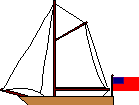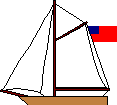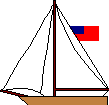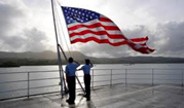6) In heraldry the correct, although little used, term for the armorial bearings of a kingdom, of an office or of a community - insignia (see also ‘armorial bearings’, ‘ensign-banner’ and ‘insignia’).
Please note with regard to 1) that the ensign is generally displayed on a staff at the stern of a vessel, or from the peak of the gaff of a sailing vessel if so rigged or two-thirds up the leech of the mainsail if not, and in the case of a naval ship, from either an ensign staff or from the rigging, with this latter depending either on tradition or operational requirements and is covered under peak.
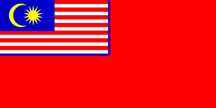
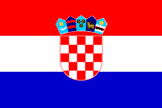
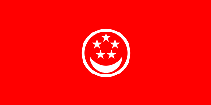
Civil Ensign of Malaysia (fotw);
Civil Ensign of Croatia (fotw);
Civil Ensign of Singapore (fotw)
2) See ‘Service Ensign’.

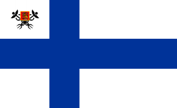

Custom Ensign of Israel (fotw);
Customs Ensign of Finland (fotw);
Customs Ensign of Moldova (fotw)
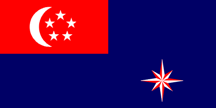


Government Ensign of
Singapore (fotw); State Ensign of
Malaysia (fotw);
Government Ensign of Cayman Islands (fotw)
Please note however, that the defaced Blue Ensigns of British Dependent Territories (as illustrated above) act as both an official flag on land, and as a Government Ensign when flown by a Government owned vessel at sea.
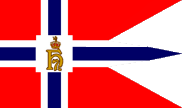
Ensign of the Royal Norwegian Yacht Club (fotw)
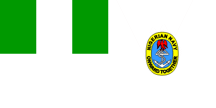
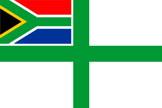
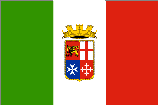
Naval Ensign of Nigeria (fotw);
Naval Ensign of The RSA (fotw);
Naval Ensign of Italy (fotw)
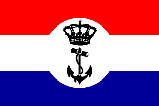
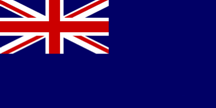

Reserve Ensign of The Netherlands (fotw);
Reserve Ensign of the UK (fotw);
Reserve Ensign 1922-1937, Yugoslavia (fotw)
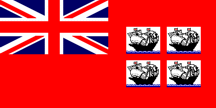
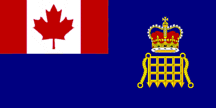

Ensign of
Trinity House, UK (fotw); Ensign of the
Eastern Canadian Customs Service (fotw);
Ensign for the Department of Supply and Service 1899, Canada (fotw)
Please note that a service ensign can also be a government ensign when the service involved is a government responsibility, for example that of the Eastern Canadian Customs illustrated above.
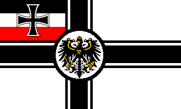
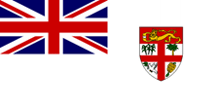
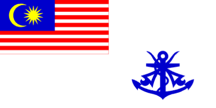
War/Naval Ensign of
Germany 1903 – 1919 (fotw); War/Naval Ensign of
Fiji (fotw);
War/Naval Ensign of Malaysia (fotw)
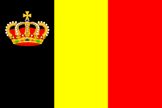


Yacht Ensign of Belgium (fotw);
Yacht Ensign of Spain (fotw);
Ensign of the Randers Sailing Club, Denmark (fotw)
Please note that in UK usage the owners of civil/leisure vessels flying a plain blue or defaced ensign are legally obliged to have the warrant/club membership papers applicable to that ensign available on board, and must produce it when requested to do so by the appropriate authorities.
![[Spanish state flag]](../images/v/vxt-d612.gif)
![[Spanish arms]](../images/v/vxt-d612a.gif)
![[ensign-banner]](../images/v/vxt-d4358.gif)
State Flag and Arms of Spain 1945 - 1977 (fotw);
Flag of Albufeira, Portugal (fotw)
Notes
a) The provenance of this term is uncertain
and its use of the description “banner” (as defined herein) inaccurate. However, a
possible derivation from insignia-banner (as opposed to armorial banner) cannot be
ignored.
b) A full set of armorial bearings (most notably in Continental
civic heraldry) need not contain all the traditional elements (such as
supporters and motto), and to avoid any potential confusion the new term
“armorial flag” (both generically and specifically) is recommended for use in
description.
![[ensign of honor]](../images/v/vxt-d5433.gif)
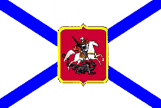
![[ensign of honor]](../images/v/vxt-d569d.gif)
Ensign of Honour, Yugoslavia 1937-1941 (fotw); Ensign of Honour 1819-1917,
Russia (fotw);
Naval Ensign of Honour, Yugoslavia 1949 – 1991 (fotw)
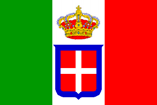
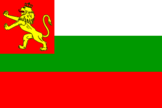
The Ensign/Naval Ensign of Italy 1848 – 1946 (fotw);
The Ensign/Naval Ensign of Bulgaria 1878 – 1908 (fotw)
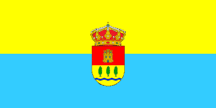

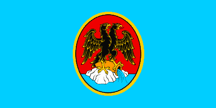
Flag of Geria, Spain (fotw);
Flag of Bellac, France (fotw);
Flag of Rijeka, Croatia (fotw)
Please note that the correct heraldic term for a charge that is placed in front of rather than at the top of another is ‘surmounted by’ as referenced above.
2) See ‘throughout’.
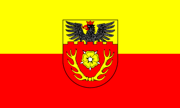
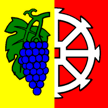
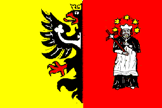
Flag of Hildesheim, Germany (fotw);
Flag of
Beringen, Switzerland (fotw); Flag of Krásné Pole,
Poland (fotw)
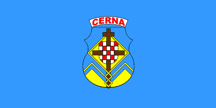

Flag and Arms of Cerna, Croatia (fotw)
![[North Rhine – Westphalia, Germany]](../images/v/vxt-d1167b.gif)
![[North Rhine – Westphalia, Germany]](../images/v/vxt-d1167a.gif)
Arms and Arms of North Rhine – Westphalia, Germany (fotw)
![[Lázně Bělohrad]](../images/v/vxt-d1168.gif)
Flag of Lázně Bělohrad Czechia (fotw)

